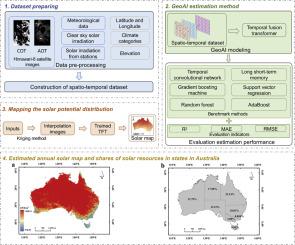一个时间融合变压器增强GeoAI框架估算每小时地表太阳辐照
IF 9.6
Q1 COMPUTER SCIENCE, ARTIFICIAL INTELLIGENCE
引用次数: 0
摘要
准确估算地表太阳辐照量对有效利用太阳能和制定太阳能光伏规划至关重要。虽然传统的机器学习方法已被证明可以有效地估计太阳辐射,但它们在大区域建模方面面临挑战,并且缺乏模拟太阳辐射的空间多样性和时间动态的能力,并且提供有限的可解释性。为了解决这些局限性,本研究提出了一个由时间融合变压器增强的地理空间人工智能框架,用于每小时估算地表太阳辐射。以澳大利亚为例,结果表明,与支持向量回归、随机森林、梯度增强机、AdaBoost、长短期记忆、时间卷积网络等方法的基准测试结果相比,该方法的决定系数、平均绝对误差和均方根误差分别高达0.90、0.25(kWh/m2)和0.63(kWh/m2),分别提高了21.62 - 66.67%、78.37 - 85.98%和62.81 - 73.25%。ConvLSTM, Transformer和Graph Neural Network。此外,模式的可解释性结果表明,在时间变量中,观测到的太阳辐照和晴空太阳辐照对模式的性能有显著贡献。结果表明,该框架提高了大面积太阳辐射估算的准确性和可解释性,为未来的研究提供了有价值的见解,并为发展可再生能源产业提供了决策支持。本文章由计算机程序翻译,如有差异,请以英文原文为准。

A temporal fusion transformer augmented GeoAI framework for estimating hourly land surface solar irradiation
Accurate estimation of land surface solar irradiation is critical for effective solar energy utilization and planning of solar photovoltaic planning. Although traditional machine learning methods have been demonstrated to estimate solar irradiation effectively, they face challenges in modeling over large regions, as well as lacking of ability to model spatial diversity and temporal dynamics of solar irradiation, and providing limited interpretability. To address these limitations, this study proposed a geospatial artificial intelligence framework augmented by Temporal Fusion Transformer for hourly estimation of land surface solar irradiation. As a case study in Australia, the results demonstrate superior performance with the coefficient of the determination, the mean absolute error, and Root Mean Square Error as high as 0.90, 0.25(kWh/m2), and 0.63(kWh/m2), showing improvements of 21.62–66.67 %, 78.37–85.98 %, and 62.81–73.25 %, respectively, compared to the benchmarks of other methods, including Support Vector Regression, Random Forest, Gradient Boosting Machine, AdaBoost, Long Short-Term Memory, Temporal Convolutional Network, ConvLSTM, Transformer, and Graph Neural Network. Furthermore, interpretability results of the model indicate that among the temporal variables, observed solar irradiation and clear sky solar irradiation significantly contribute to the model’s performance. The results show this framework enhanced accuracy and interpretability for solar irradiation estimation over large areas, providing valuable insights for future studies and supporting decision-making for developing the renewable energy industry.
求助全文
通过发布文献求助,成功后即可免费获取论文全文。
去求助
来源期刊

Energy and AI
Engineering-Engineering (miscellaneous)
CiteScore
16.50
自引率
0.00%
发文量
64
审稿时长
56 days
 求助内容:
求助内容: 应助结果提醒方式:
应助结果提醒方式:


